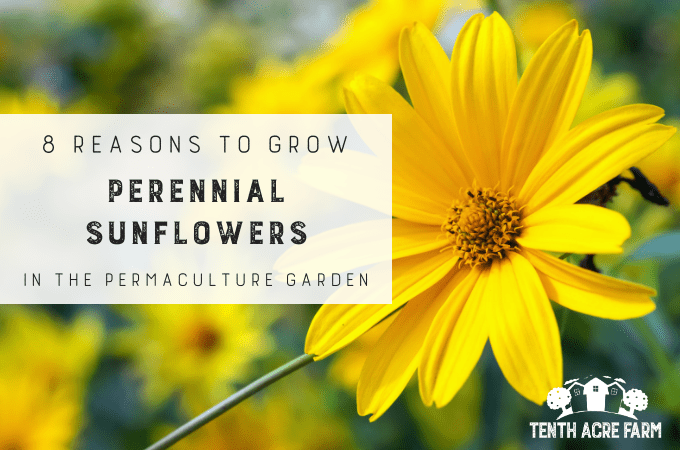8 Reasons to Grow Perennial Sunflowers in the Permaculture Garden
Perennial sunflowers are beautiful and multifunctional. Learn 8 reasons to grow native sunflowers in your permaculture garden as an ecological powerhouse.


This page may contain affiliate links. Please read my disclosure for more info.
Sunflowers (Helianthus) have a long history as a useful and edible plant for Native Americans. In fact, there are 150 species of sunflower, most of which are native to North America. You may already be familiar with annual sunflowers ( H. annuus), which are quite delightful in the garden and provide delicious edible seeds.
Perennial sunflowers are also quite cheery and useful, with many varieties to choose from, spread across most growing zones with a variety of heights and bloom sizes.
Regardless of the variety of perennial sunflowers you choose, the blooms are a lovely addition to the edible landscape. They also increase biodiversity and are super useful in the permaculture garden.
How I Met Perennial Sunflowers
I was first introduced to perennial sunflowers years ago when Mr. TAF and I were planning our wedding.
We found Karen and Ed of Wildey Flower Farm at the farmers’ market, and fell in love with their gorgeous bouquets and fun personalities. So we asked them to supply wildflower arrangements for our wedding.
They scratched their heads and said that cut flower requests for wildflowers weren’t typical for late September. After all, most things are finished blooming by that date!
Still, they invited us out to the farm, where we took a ride through the farm fields, pointing out the different things blooming. The thing is, most wildflowers are so common that they don’t catch the eye of most brides.
Karen and Ed were surprised by our enthusiasm for the wildflowers, but they took on the challenge. In the end, we were thrilled with their artful combinations of goldenrod, thistle, asters, and more, with the perennial sunflowers taking center stage in the wedding bouquets.


Here’s me with my wildflower bouquet starring perennial sunflowers.
Multifunctional Plants in Permaculture
I didn’t realize how useful perennial sunflowers were until after the wedding, when I started to learn more about permaculture. Through permaculture, we seek to design food-growing systems that also regenerate ecology.
By using multifunctional plants, we can create a web of connectedness throughout the garden, which can reduce work as well as reduce the need to import materials.
(Curious about permaculture? Read: What is Permaculture? Designing a Resilient Garden).
Excited about the multifunctional aspects of perennial sunflowers, I planted Maximilian sunflower (Helianthus maximiliani) on the edge of our community garden. While we got some blooms, it didn’t form a thick planting like I had hoped.
Unfortunately, they don’t thrive in the shade.


Maximilian sunflowers at the community garden
Growing Habits of Perennial Sunflowers
Where you grow perennial sunflowers takes some planning, since they can grow from 3-8 feet tall in ideal conditions. Their rhizomatous roots can spread rapidly. Therefore, plant them where they can spread out, or where you can mow a perimeter around them for containment.
Most perennial sunflowers grow in full sun in zones 3-9, and flower in the late summer through fall. They naturally grow in sunny prairies, quite comfortably among grasses, and are very drought tolerant.
You may also find them growing in disturbed areas, such as along roadsides. Just look for their yellow, daisy-like blooms.
Grow them in moist but not waterlogged soil that is well-drained. If the soil is too rich and moist, the plants may grow weak and spindly and flop over.
Want to grow fruits, vegetables, and herbs in your front yard landscape without sacrificing curb appeal? Check out my mini guide, The Permaculture Inspired Edible Landscape.
8 Reasons to Grow Perennial Sunflowers in the Permaculture Garden
Over the years, I’ve fallen in love with how useful this plant is. It’s a great example of stacking functions.
Native Americans used the plants for food, oil, dye, and thread, according to the USDA Natural Resources Conservation Service. Reportedly, pioneers planted them near their homes to repel mosquitoes.
The following are some of the reasons why perennial sunflowers might be the right plant for your landscape or garden.
#1: Perennial sunflowers are edible.
Perennial sunflowers don’t have the big seeds that annual sunflowers produce. However, the small seeds—harvested in late October and November—were eaten by Native Americans as a snack and sprinkled on salads and other foods.
Try saving the seeds to make sunflower oil (though they aren’t as productive as black oil sunflower seeds).
Jerusalem artichokes, also called sunchokes (Helianthus tuberosus), are perhaps the most popular of perennial sunflowers in this department. Known for their nutritious, edible roots, they’re a smart addition to the survival garden.
To harvest the edible tubers of perennial sunflowers, dig them up in the fall after the plants are finished flowering. Learn more about growing Jerusalem artichokes and cooking with them.
The young green shoots of perennial sunflowers are also delicious. Harvest the shoots in early spring and eat them raw or cooked.


Jerusalem artichoke edible tubers
#2: They are deer resistant.
According to Toby Hemenway in Gaia’s Garden, Maximilian sunflower (Helianthus maximiliani) has the ability to create a formidable barrier, and can be planted in sunny spaces to deter deer.
Deer occasionally browse the seed heads in the fall, so you’ll want to beat them to harvesting the seeds if that is your interest. Harvest the seeds by cutting the spent blooms.
These cute but pesky animals don’t seem to like the stiff, spikey stems that remain after cutting the seed heads, so you can leave the dead stalks as a deterrent. Simply cut the stalks to the ground over winter to make way for new shoots in spring.
#3: Create a hedgerow with perennial sunflowers.
Hedgerows are great as windbreaks or privacy screens, among other reasons, and perennial sunflowers may be perfect as a thick screen during the growing season.
The roots form a thick barrier that keeps grass from creeping into an area where you don’t want it. Toby Hemenway calls this type of plant a ‘fortress plant’. Comfrey is another good fortress plant, though it isn’t made for prairie habitat.
For year-round privacy and other purposes, consider planting perennial sunflowers in a mixed hedgerow.
#4: Create your own mulch and compost.
Grown in full sun, perennial sunflowers develop into a thick patch over time. Chopping it back at the end of the season yields a huge amount of biomass.
You can chop and spread this biomass over gardens to protect soil, or add it to the compost bin to create your own rich soil amendment.
Here are some more ideas for mulching in the permaculture garden.
#5: Restore a native prairie with perennial sunflowers.
The roots of this native prairie plant produce a chemical that allows the plants to hold their own among grasses. You can sow seeds or plant perennial sunflower seedlings directly into grasslands to restore prairie habitat and to introduce biodiversity.


#6: Reduce erosion and water pollution.
Perennial sunflowers have a root crown and a rhizomatous root system that form a dense underground cluster. This root structure is excellent for erosion control, easily holding soil in place and absorbing water and nutrients.
For this reason, they are often grown on a slope to slow water and capture nutrients.
Try growing perennial sunflowers with grasses in a filterstrip—a buffer planting that protects a stream from sediment buildup and agricultural or roadway runoff.
See How to Prevent Soil Erosion in Gardens and on Farms
#7: Foster wildlife with perennial sunflowers.
The density of perennial sunflower patches, especially when combined in mixed-species hedgerows, produces habitat and cover for birds and other small wildlife.
What’s more, butterfly caterpillars feed on the foliage.
Tired of generic permaculture design advice that you can’t apply to your specific goals? If so, check out my Permaculture Design Program and get the tools and support needed to create and implement your own permaculture design.
#8: Attract pollinators and beneficial insects.
Pollinators such as butterflies, beetles, and all manner of bees are attracted to the pollen and nectar, especially in the late summer and early fall when not much else is blooming.
Perennial sunflowers attract ladybugs, lacewings, syrphid flies, and parasitic wasps, who patrol the area for a variety of aphids, caterpillars, and other plant-sucking garden pests. They contribute to a natural pest prevention system.
Planting Perennial Sunflowers
Sow perennial sunflower seeds either in the fall or in the spring after the last frost. (Get seeds here.)
If sowing in the spring, the seeds must first be cold stratified, which means they need a period of cold to germinate.
To cold stratify the seeds indoors, start about 8-10 weeks before your spring frost date. Put seeds in a ziplock bag with moistened seed starting medium, and store in the refrigerator for 30 days. Check the seeds weekly, and if they begin to germinate, it’s time to plant them.
Sow the stratified seeds indoors under lights. For details on seed starting, see my step-by-step guide. Plant them outside after the danger of frost has passed.
Summary
Perennial sunflowers are bright, cheery flowers for any landscape, but you can also put them to work in the permaculture garden.
With their ability to provide food, mulch, compost, and deer barriers; reduce erosion and attract wildlife and beneficial insects; perennial sunflowers are a multifunctional plant that can reduce work and increase biodiversity.
How will you use perennial sunflowers in your garden?
READ NEXT:









